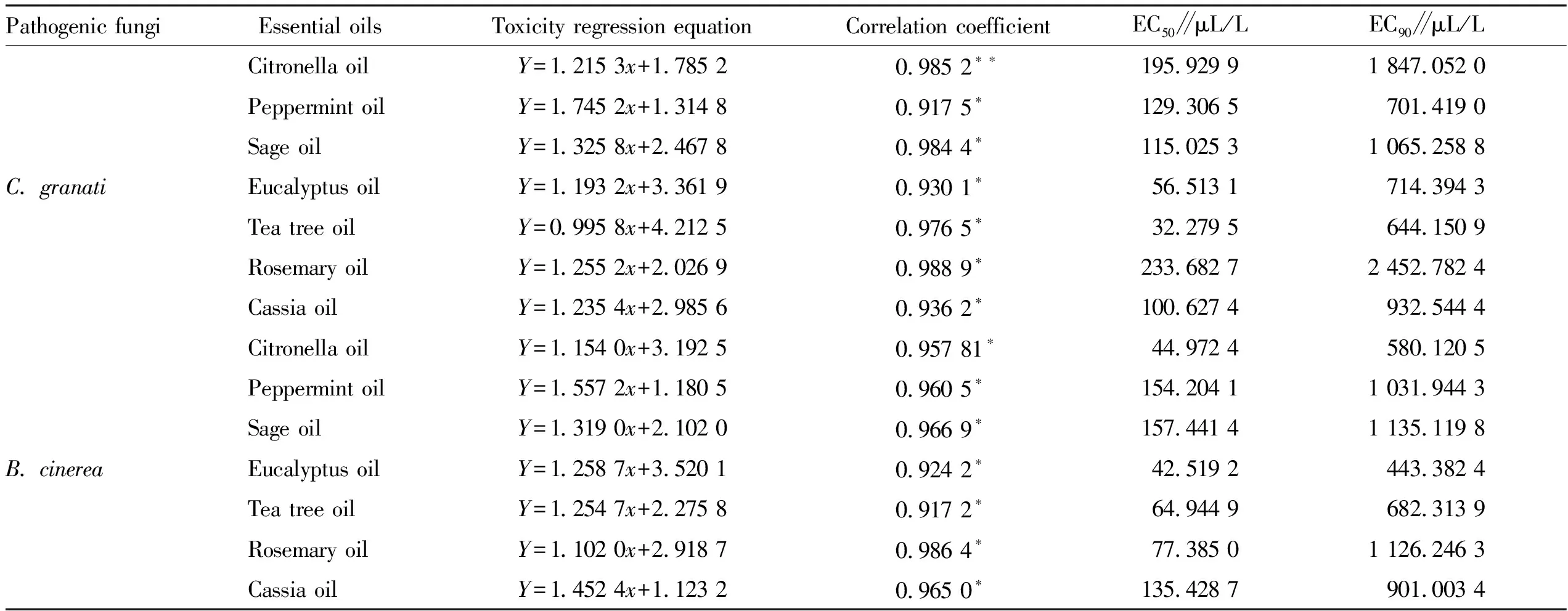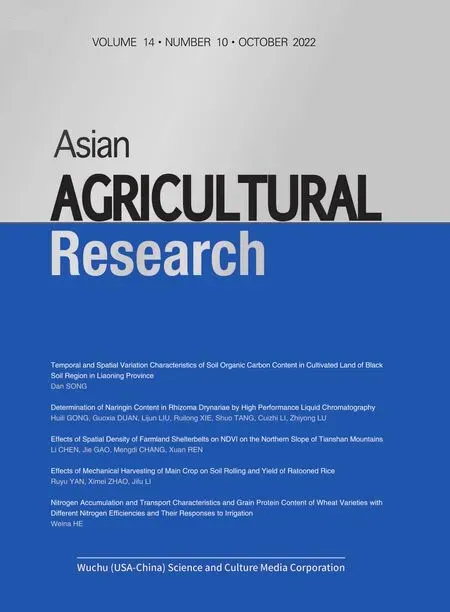Antibacterial Effects of Essential Oils from Pomegranate on Two Kinds of Postharvest Pathogenic Fungi
Xin YAO, Yong TU, Chuandong LIU
School of Agricultural Science, Xichang University, Xichang 615013, China
Abstract [Objectives]To explore the antibacterial effects of essential oils from pomegranate on two kinds of postharvest pathogenic fungi, and to provide reference for the exploration of new plant-derived preservatives for pomegranate.[Methods]The inhibitory effects of 15 kinds of plant essential oils on 2 kinds of pomegranate postharvest pathogenic fungi were studied.[Results]Tea tree oil and eucalyptus oil have good inhibitory effects on the mycelium growth of Coniella granati and Botrytis cinerea, and the fumigation treatment of pomegranate can inhibit the rot of fruit during storage to a certain extent.[Conclusions]Tea tree oil and eucalyptus oil can effectively inhibit the mycelium growth of two kinds of pathogenic fungi, and can better control the rot of pomegranate during storage.It is necessary to further study the fresh-keeping effect and antibacterial mechanism of plant essential oils on pomegranate.
Key words Pomegranate, Postharvest disease, Antibacterial effect, Plant essential oil
1 Introduction
Pomegranate(Punicagranatum)is a deciduous tree or shrub, belonging to the genusPunicaLinn.of the Punicaceae family.Because of its crystal clear and juicy seeds, moderate sweet and sour, and rich in nutrients, it is very popular among consumers.At present, China ranks first in the planting area in the world.The Panxi region of Sichuan Province has become the largest pomegranate producing area in China[1].During the storage period of pomegranate, the pomegranate peel is prone to many problems such as browning, shrinkage, and diseases.These are further extended to the pomegranate grains, and will easily change color, taste or even rot, and accordingly greatly influencing the commodity value.The synergistic effect of multiple pathogenic bacteria is a main cause of pomegranate rot and decay.Essential oils are natural plant extracts and often contain bioactive components that inhibit pathogenic bacteria.Plant essential oils have significant antibacterial activity and a wide range of antibacterial spectrum, and have small side effects and low residual toxicity, thus have become one of the research hotspots in the field of fruit and vegetable preservation[2-4].In this experiment, we selected 15 kinds of plant essential oils, and preliminarily explored their inhibitory effects on two kinds of pomegranate postharvest pathogenic fungi, in order to provide a reference for the exploration of new plant-derived preservatives for pomegranate.
2 Materials and methods
2.1 Experimental materials
2.1.1Test pomegranate.The pomegranate variety is Tunisian soft seed pomegranate.We picked pomegranates on August 26, 2020 in Huanglianguan Town, Xichang City, Liangshan Yi Autonomous Prefecture, Sichuan Province.We selected pomegranates with complete fruit shape, no pests and diseases, and no mechanical damage.
2.1.2Test strains.The test strains selectedConiellagranatiandBotrytiscinerea, provided by Research Team of Pomegranate Storage and Processing, Xichang University.
2.1.3Test essential oils.The peppermint oil, eucalyptus oil, cassia oil, ginger oil, garlic oil, clove oil are all single essential oils, purchased from Jiangxi Xuesong Natural Medicinal Oil Co., Ltd.; the tea tree oil, rosemary oil, sage oil, citronella oil, thyme oil, forsythia oil, absinthe oil, mandarin oil, andLitseacubebaoil are all single essential oils purchased from Jiangxi Xiyuan Spice Oil Co., Ltd.
2.2 Experimental methods
2.2.1Activation of strains.The test strains were inoculated on potato dextrose agar medium(PDA), and cultured at 25 ℃ for 5 d.
2.2.2Determination of the diameter of the inhibition zone by the Oxford cup method.
Using the Oxford cup method[5], we determined the resistance of the two test strains to the stock solution of plant essential oils.Took a single bacteria in the center of the PDA medium, placed 3 Oxford Cups(D=5 mm)at the center and other distances, injected essential oil in the cup, cultured at 25 ℃ constant temperature for 4 d, and measured the diameter of the inhibition zone(cm)by the cross method.
2.2.3Indoor toxicity determination.Using the growth rate method[6], dissolved the initially screened 7 kinds of plant essential oils with a little Tween-80, and prepared the medium containing plant essential oils with concentrations of 2 000.0, 1 000.0, 500.0, 250.0, 100.0, 50.0, 25.0 and 12.5 μL/L.Taking Tween-80 as a control, repeated each concentration 3 times, inoculated with the test strains in the center of the medium, and cultured at a constant temperature of 25 ℃ for 5 d, and measured the diameter of the inhibition zone(cm)by the cross method.Then, calculated the inhibition rate and toxicity regression equation, and calculated EC50and EC90.
2.2.4Fresh-keeping and preservative effects of essential oil fumigation on pomegranate fruit.Packaged the pomegranate fruit wholly in PE bag(thickness 0.01 mm), evenly coated the two kinds of plant essential oils that were selected according to the EC90treatment concentration calculated based on the indoor toxicity test on the filter paper(14.0 cm×10.0 cm)and pasted on the inside of the preservative film, stored at 25 ℃, counted the rotten number and rot grade of pomegranate fruits in each treatment group on the 25thday, and calculated the rot rate and rot index[7].Each treatment had 30 pieces of fruits and repeated 3 times.
2.3 Data analysisWe processed and analyzed data with the aid of Excel 2010 and SPSS 19.0.
3 Results and analysis
3.1 Inhibitory effect of plant essential oils on two kinds of pomegranate postharvest pathogenic fungiAs shown in Table 1, 15 kinds of test plant essential oils had different degrees of inhibitory effect on the mycelium growth of 2 kinds of pomegranate postharvest pathogenic fungi.Specifically, 7 kinds of plant essential oils citronella oil, peppermint oil, sage oil, eucalyptus oil, tea tree oil, rosemary oil and cassia oil had better inhibitory effect, and the diameter of their inhibition zone was greater than 6.00 cm, while the inhibition effect of thyme oil and mandarin oil was weaker, and the diameter of the inhibition zone was less than 2.00 cm.
3.2 Toxicity determination of 7 kinds of plant essential oils with better antibacterial effect on 2 kinds of pomegranate postharvest pathogenic fungiWe further determined the indoor toxicity of 7 kinds of plant essential oils.From Table 2, it can be known that tea tree oil and eucalyptus oil had stronger toxicity.The EC50values of tea tree oil against two pathogenic fungi were 32.279 5 and 64.944 9 μL/L, respectively, the EC90values were 644.150 9 and 682.313 9 μL/L, the average EC50and EC90values were 48.612 2 and 663.232 4 μL/L, respectively.The EC50values of eucalyptus oil against the two pathogenic fungi were 56.513 1 and 42.519 2 μL/L, respectively, the EC90values were 714.394 3 and 443.382 4 μL/L, respectively, and the average EC50and EC90were 49.516 2 and 578.888 4, respectively, and the difference was not significant.In addition, citronella oil also has a good inhibitory effect onB.cinerea, its EC50and EC90values were 44.972 4 and 580.120 5 μL/L, respectively.

Table 1 Inhibitory effect of plant essential oils on two kinds of pomegranate postharvest pathogenic fungi

Table 2 Toxicity determination of 7 kinds of plant essential oils with high antibacterial effect on 2 kinds of pomegranate postharvest pathogenic fungi
3.3 Control effect of plant essential oils on postharvest diseases of pomegranateThe pomegranate was fumigated with tea tree oil and eucalyptus oil, and the changes in the rot rate and rot index of the fruit during storage are shown in Table 3.We can see that booth tea tree oil and eucalyptus oil could inhibit the rot of pomegranate during storage to a certain extent.When stored for 21 d, the decay rates of the eucalyptus oil and tea tree oil treatment groups were 16.67% and 20.83%, respectively, and the decay indexes were 0.20 and 0.25, respectively, which were significantly lower than those of the control group(P>0.05).At this time, the decay rate and decay index of the control group separately reached 33.33% and 0.41.

Table 3 Effects of two kinds of plant essential oil treatments on the storage period of pomegranate
4 Conclusions and discussion
The experimental results of the antibacterial effect of plant essential oils on two kinds of pomegranate postharvest pathogenic fungi showed that tea tree oil and eucalyptus oil could effectively inhibit the mycelium growth of two kinds of pathogenic fungi, and could well control the rot of pomegranate during storage.
At present, there is no relevant report on the use of plant essential oils to control postharvest diseases of pomegranate in China, but there are many in other fruit and vegetable products.Pan Xiaojunetal.[8]studied the antibacterial effect of 13 kinds of plant essential oils using cucumber anthracnose as the test material, and found that cinnamon bark oil, oregano oil and clove oil had better effects, which could effectively prolong the storage period of cucumber and delay the decline of cucumber quality.Through studying the effects of 5 kinds of plant essential oils on the pathogenic bacteria of postharvest black spot disease of blueberry, Wang Danetal.[8]found that cinnamon bark oil has a strong inhibitory effect on the mycelium growth ofAlternariaalternata, can reduce the incidence of black spot disease on blueberry fruit to a certain extent, and has a good control effect on postharvest black spot disease of blueberry.Liu Ruilingetal.[10]selected 6 kinds of plant essential oils to conduct antibacterial experiments on postharvest pathogens of red pitaya fruit, and found that the essential oil of carvacrol has the best antibacterial effect onFusariumlamelliformisandPseudomonasanthracis.
In recent years, there are few reports on the application effect and safety of new preservatives on pomegranate.The plant essential oil, as a new type of antibacterial agent, is worthy of further exploration, so as to screen out an efficient, safe and comprehensive method for the comprehensive control of various postharvest pathogenic bacteria in pomegranate.However, the interaction between plant essential oils, pathogenic bacteria and fruits is complex.Therefore, at the same time of considering sterilization and preservation, it is also necessary to take full consideration of other quality indicators of the fruit.In summary, it is necessary to further study the fresh-keeping effect and antibacterial mechanism of plant essential oils on pomegranate.
 Asian Agricultural Research2022年10期
Asian Agricultural Research2022年10期
- Asian Agricultural Research的其它文章
- Nitrogen Accumulation and Transport Characteristics and Grain Protein Content of Wheat Varieties with Different Nitrogen Efficiencies and Their Responses to Irrigation
- Construction of Water-saving Ecological Aquaculture Model in Ponds in North China
- Spatio-temporal Evolution of Landscape Pattern and Habitat Quality in Yunnan Province
- Comparison of Benefits of Different Tobacco Loading Methods and Matching Baking Processes in Intensive Curing Houses
- Effects of Mechanical Harvesting of Main Crop on Soil Rolling and Yield of Ratooned Rice
- Relationship between Vegetation Index and Forest Surface Fuel Load in UAV Multispectral Remote Sensing
